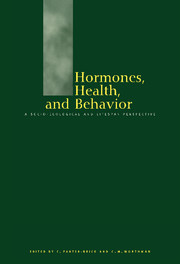Book contents
- Frontmatter
- Contents
- Contributors
- 1 Contributions of biological anthropology to the study of hormones, health, and behavior
- 2 Hormonal correlates of personality and social contexts: from non-human to human primates
- 3 Epidemiology of human development
- 4 Family environment, stress, and health during childhood
- 5 Work and hormonal variation in subsistence and industrial contexts
- 6 Reproductive ecology and reproductive cancers
- 7 Diet, hormones, and health: an evolutionary–ecological perspective
- 8 Modernization, psychosocial factors, insulin, and cardiovascular health
- Index
4 - Family environment, stress, and health during childhood
Published online by Cambridge University Press: 29 January 2010
- Frontmatter
- Contents
- Contributors
- 1 Contributions of biological anthropology to the study of hormones, health, and behavior
- 2 Hormonal correlates of personality and social contexts: from non-human to human primates
- 3 Epidemiology of human development
- 4 Family environment, stress, and health during childhood
- 5 Work and hormonal variation in subsistence and industrial contexts
- 6 Reproductive ecology and reproductive cancers
- 7 Diet, hormones, and health: an evolutionary–ecological perspective
- 8 Modernization, psychosocial factors, insulin, and cardiovascular health
- Index
Summary
Introduction
In a child's world, the family is of paramount importance. Throughout human evolutionary history, parents and close relatives provided calories, protection, and information necessary for survival, growth, health, social success, and eventual reproduction. The human brain is therefore likely to have evolved special sensitivity to interactions among family caretakers, particularly during infancy and early childhood. This special sensitivity for negotiating the psychosocial dynamic of the family environment has important consequences for child development.
Changing, unpredictable environments require adjustment of priorities. Growth, immunity, digestion, and sex are irrelevant when being chased by a predator (Sapolsky, 1994), or when coping with a traumatic social event. Emergencies, large and small, good and bad, perceived by the brain stimulate a variety of neuroendocrine systems. Hundreds of different endogenous chemicals, hormones, neurotransmitters, cytokines, and so forth, are released from secretory glands and cells in response to information received and processed by the central nervous system (CNS). The movement of these chemicals in plasma and other intercellular fluids communicates information among the different cells and tissues, helping the body to respond appropriately to varying environmental demands.
Physiological stress responses affect the allocation of energetic and other somatic resources to different bodily functions via a complex assortment of neuroendocrine mechanisms.
- Type
- Chapter
- Information
- Hormones, Health and BehaviourA Socio-ecological and Lifespan Perspective, pp. 105 - 138Publisher: Cambridge University PressPrint publication year: 1998
- 5
- Cited by



